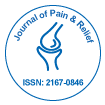The Intersection of Opioids, Stress, and Addiction
Received: 01-Jan-2025 / Manuscript No. jpar-25-161040 / Editor assigned: 03-Jan-2025 / PreQC No. jpar-25-161040(PQ) / Reviewed: 17-Jan-2025 / QC No. jpar-25-161040 / Revised: 22-Jan-2025 / Manuscript No. jpar-25-161040(R) / Published Date: 29-Jan-2025
Abstract
Opioid addiction has emerged as a global health crisis, affecting millions of individuals and straining healthcare systems worldwide. The interplay between stress and opioid addiction has gained increasing attention due to its significant role in substance use initiation, maintenance, and relapse. This article explores the complex neurobiological and psychological mechanisms linking stress and opioid addiction, emphasizing the involvement of the hypothalamicpituitary- adrenal (HPA) axis, neurotransmitter systems, and behavioral conditioning. Understanding these interactions is crucial for developing more effective prevention and treatment strategies. The discussion includes the impact of chronic stress on opioid receptor function, the role of the endogenous opioid system in stress response, and the behavioral consequences of stress-induced drug-seeking behaviours. Novel therapeutic approaches, including pharmacological and behavioral interventions, are also reviewed to highlight potential pathways for addressing opioid addiction in individuals exposed to high stress levels.
Keywords
Opioids; stress; Addiction; Neurobiology; HPA axis; Opioid receptors; Substance use disorder; relapse; Behavioral conditioning; Pharmacological interventions
Introduction
The global opioid crisis has reached alarming levels, with opioid-related overdoses and deaths rising dramatically in recent years. Opioid addiction, classified as opioid use disorder (OUD), is characterized by compulsive drug-seeking behaviour, tolerance, and withdrawal symptoms. Stress has been identified as a critical factor in the initiation, progression, and relapse of opioid addiction. The relationship between stress and opioid use is bidirectional, as chronic stress can increase susceptibility to opioid addiction, while opioid use can alter the brain’s stress response mechanisms. Investigating these interactions from a neurobiological and psychological perspective provides valuable insights into the underlying mechanisms of addiction and potential therapeutic interventions [1,2].
Description
Stress activates the Hypothalamic-Pituitary-Adrenal (HPA) axis, leading to the release of cortisol, a stress hormone that influences brain function and behaviour. In individuals vulnerable to addiction, prolonged activation of the HPA axis can enhance the reinforcing effects of opioids, making drug use more appealing as a coping mechanism. Opioids, in turn, modulate the brain’s reward circuitry by interacting with the mesolimbic dopamine system, reinforcing drug-seeking behaviours. The endogenous opioid system, which includes endorphins, enkephalins, and dynorphins, plays a critical role in regulating pain, stress, and mood. Dysregulation of this system due to chronic opioid use or persistent stress can lead to altered opioid receptor sensitivity, increased drug cravings, and greater difficulty in achieving sustained recovery [3,4].
Results
Studies have demonstrated that stress exposure significantly increases opioid self-administration in both animal and human models. Research findings indicate that individuals with a history of early-life adversity or chronic stress have heightened responsiveness to opioid rewards. Neuroimaging studies reveal that chronic opioid users exhibit altered activity in brain regions involved in stress processing, such as the amygdala and prefrontal cortex. Furthermore, opioid withdrawal symptoms, which include anxiety and hyperalgesia, further exacerbate stress-related neurobiological changes, making relapse more likely. Clinical observations suggest that patients with co-occurring stress-related disorders, such as post-traumatic stress disorder (PTSD) and depression, are at a greater risk of opioid misuse and dependence [5].
Discussion
The intricate relationship between stress and opioid addiction underscores the necessity of a multifaceted treatment approach. Pharmacological treatments, including methadone, buprenorphine, and naltrexone, have shown efficacy in mitigating opioid dependence; however, these treatments alone may not be sufficient for individuals with high stress reactivity. Behavioral therapies, such as Cognitive-Behavioral Therapy (CBT) and Mindfulness-Based Stress Reduction (MBSR), have demonstrated promising results in reducing stress-induced drug cravings and relapse rates. Additionally, interventions aimed at modifying stress response pathways, such as neuro feedback and stress inoculation training, hold potential for improving treatment outcomes. Future research should focus on identifying biomarkers of stress susceptibility in opioid users and developing targeted interventions tailored to individual stress profiles.
Conclusion
Opioid addiction is a complex disorder influenced by neurobiological, psychological, and environmental factors. Stress plays a pivotal role in the initiation and maintenance of opioid addiction, primarily through dysregulation of the HPA axis, alterations in the endogenous opioid system, and reinforcement of maladaptive drug-seeking behaviours. Effective treatment strategies must address both the physiological and psychological dimensions of addiction, incorporating pharmacological and behavioral interventions to mitigate stress-related vulnerabilities. A comprehensive understanding of the stress-opioid relationship is essential for developing innovative and personalized approaches to combat the opioid epidemic and improve long-term recovery outcomes.
References
- Linaker CH, Walker-Bone K (2015) . Best Pract Res Clin Rheumatol 29: 405-423.
- Rees JD, Wilson AM, Wolman RL (2006) . Rheumatology 45: 508-521.
- Van Der Windt DA, Koes BW, de Jong BA, Bouter LM (1995) . Ann Rheum Dis 54: 959-964.
- Redler L, Dennis E (2019) . J Am Acad Orthop Surg 27: 544-554.
- Neviaser AS, Neviaser RJ (2011) . J Am Acad Orthop Surg 19: 536-542.
, ,
, ,
, ,
, ,
, ,
Citation: Ahmed R (2025) The Intersection of Opioids, Stress, and Addiction. J Pain Relief 14: 704.
Copyright: © 2025 Ahmed R. This is an open-access article distributed under the terms of the Creative Commons Attribution License, which permits unrestricted use, distribution, and reproduction in any medium, provided the original author and source are credited.
Share This Article
Recommended Conferences
Toronto, Canada
Recommended Journals
51ºÚÁϳԹÏÍø Journals
Article Usage
- Total views: 47
- [From(publication date): 0-0 - Apr 27, 2025]
- Breakdown by view type
- HTML page views: 29
- PDF downloads: 18
